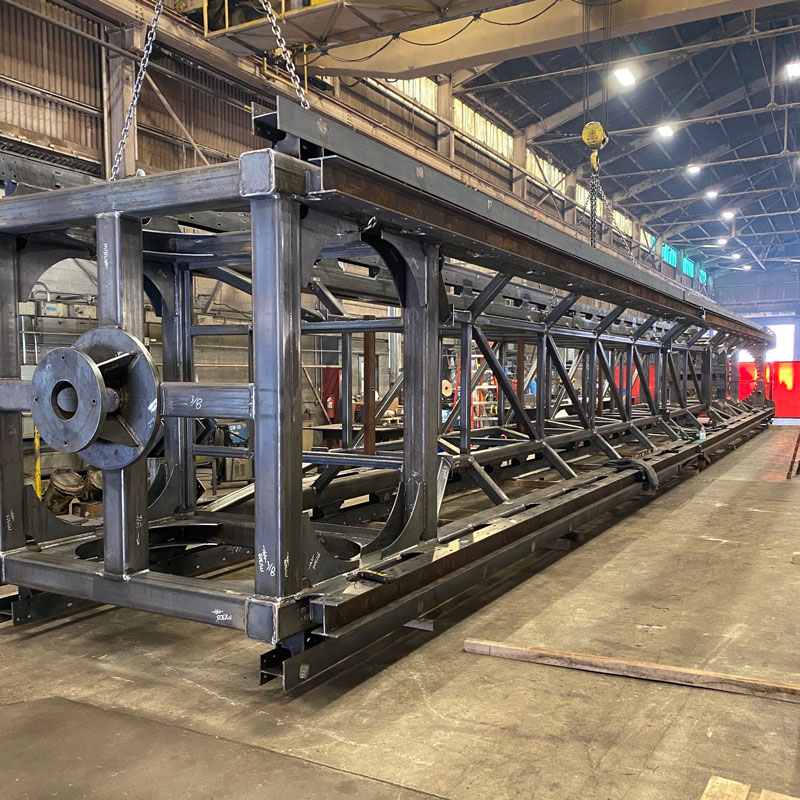The Ultimate Handbook on Custom-made Steel Manufacture Solutions for Structural Projects
In the realm of structural jobs, the importance of custom steel fabrication solutions can not be overemphasized. From the foundational understanding of steel manufacture basics to the detailed procedure of picking the most ideal materials, every action in this trip plays a critical role in the ultimate success of a project. As we browse via the intricacies of design factors to consider, manufacture processes, and top quality control procedures, a comprehensive manual serves as a directing light for experts seeking excellence in steel manufacture options. Remain tuned to uncover the understandings that can change the means structural jobs are come close to and implemented.
Understanding Custom-made Steel Construction Fundamentals
Exploring the principles of custom-made steel fabrication provides understanding into the intricate process of changing raw steel right into customized structural elements. Personalized steel fabrication is a customized production strategy that includes cutting, shaping, and constructing steel materials to produce special frameworks according to particular task demands. Understanding the basics of custom-made steel manufacture is essential for making certain the effective implementation of architectural tasks.
The process normally begins with the assessment of project requirements and style needs. This initial phase involves thorough preparation and partnership between engineers, designers, and makers to establish one of the most ideal method for making the steel parts. Precision is key during the construction procedure, as also small inconsistencies can impact the architectural stability of the last item.
Various techniques, such as reducing, welding, and shaping, are employed to change raw steel right into the preferred architectural elements. Skilled fabricators use sophisticated equipment and devices to guarantee accuracy and consistency throughout the construction process. Quality assurance procedures are applied to confirm the honesty of the fabricated components prior to they are set up on-site, making sure conformity with market standards and job requirements.
Picking the Right Steel Materials

Primarily, the type of architectural job and its details demands play an essential duty in figuring out one of the most appropriate steel products. Aspects such as the load-bearing capability, environmental conditions, and desired life-span of the structure will certainly determine the quality and kind of steel that should be made use of.
Additionally, the physical properties of the steel, including ductility, weldability, and strength, have to align with the task's demands to ensure optimal efficiency and resilience (metal fabrication melbourne). In addition, factors to consider such as rust resistance, cost-effectiveness, and accessibility of the steel products must also be thought about during the choice procedure
Layout Considerations for Architectural Jobs
Architectural projects demand meticulous focus to design factors to consider to make sure both capability and safety are prioritized throughout the construction procedure. When it involves creating architectural projects, several key aspects need to be taken right into account to guarantee the success of the undertaking. The structural honesty of the structure have to be a top concern. This includes evaluating loads, anxieties, and environmental factors to determine one of the most appropriate layout that can stand up to different conditions in time. Additionally, factors to consider for the capability of the framework play a vital role in the style process. Comprehending the objective of the building and how it will be used aids in developing a design that makes the most of efficiency and functionality. Furthermore, incorporating aspects that boost the aesthetics of the structure can further elevate the general style. Stabilizing aesthetic appeal, capability, and security is vital in creating effective architectural jobs that satisfy both visual and practical demands. By thoroughly taking into consideration these facets throughout the style stage, engineers and designers can ensure the structural task's success from perception to completion.
Simplifying Manufacture Processes for Performance

Additionally, implementing lean production concepts can significantly enhance efficiency in steel fabrication. By lessening waste, optimizing operations, and boosting communication between various teams included in the construction procedure, jobs can be finished more quickly and with better criteria.
In addition, developing an efficient production timetable and process can help in prioritizing tasks, designating resources successfully, and conference task target dates promptly. By having a clear plan in area and consistently monitoring progress, any type of prospective traffic jams or delays can be identified and dealt with immediately, guaranteeing smooth and reliable fabrication processes for architectural projects.
Quality Assurance and Task Monitoring in Steel Manufacture
To make sure the successful implementation of steel fabrication tasks, precise quality assurance steps and effective task monitoring methods are essential parts in preserving precision and conference customer assumptions. Quality assurance in steel fabrication entails extensive examinations at numerous phases of the fabrication process to confirm conformity with task specifications and market criteria. his explanation This includes product testing, dimensional checks, and weld examinations to make certain architectural honesty and security.
Task management plays an essential role in collaborating the various elements of steel fabrication jobs, such as organizing, source allotment, and communication amongst group members. A distinct task plan with clear purposes, turning points, and timelines helps to monitor progress and address any type of prospective concerns proactively. Efficient communication between all stakeholders, consisting of customers, engineers, makers, and specialists, is crucial for making sure that the project proceeds efficiently and fulfills the desired high quality requirements.
Conclusion
To conclude, custom steel manufacture plays a critical function in architectural tasks by this content offering tailored remedies using the ideal products and design factors to consider. Efficiency in fabrication processes, quality assurance, and reliable task administration are necessary for successful end results. By comprehending the basics of personalized steel construction and executing streamlined procedures, project teams can supply long lasting and top notch structures that meet the details demands of their clients.
Custom-made steel construction is a customized manufacturing strategy that includes cutting, shaping, and constructing steel products to create special structures according to details project needs.To make certain the effective execution of steel manufacture jobs, meticulous high quality control actions and efficient job monitoring practices are necessary parts in maintaining precision and meeting client expectations. Quality control in steel fabrication involves rigorous examinations at different stages of the fabrication process to validate compliance with project specifications and market standards (steel fabricators melbourne).Task management plays an essential function in coordinating the different facets of steel manufacture projects, such visit this site as scheduling, resource allotment, and communication among team members.In final thought, custom-made steel construction plays a vital role in structural tasks by supplying tailored solutions utilizing the right products and style factors to consider